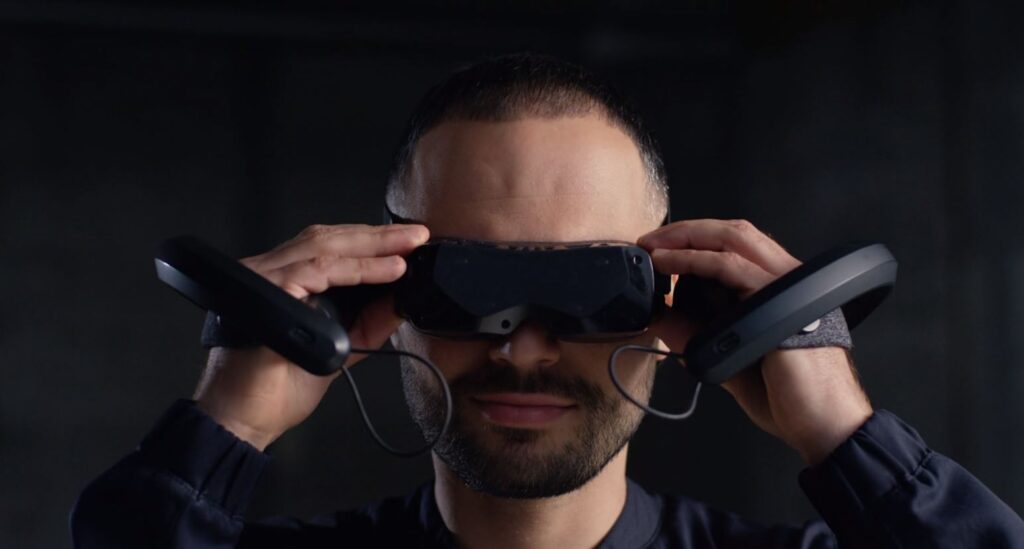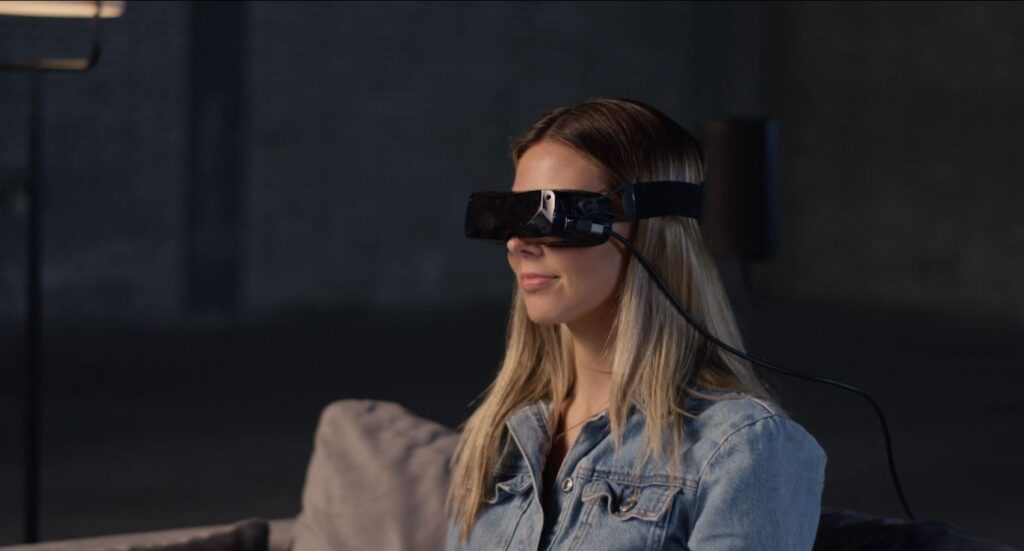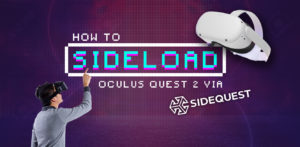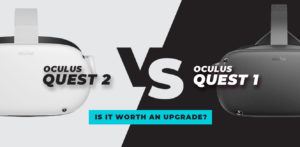It’s not very often we see an app developer take the next big leap and start designing the hardware to best run their app on. Enter Bigscreen! We’re all familiar with the very popular Bigscreen beta app that allows for the social streaming of content in multiple 3D environments. Getting to virtually go to the cinema with your buddies is such an enjoyable experience and the company deserves all the success and attention that has come from creating such an innovative streaming platform.
Not ones to rest on their laurels though, Bigscreen are putting the finishing touches to their very own VR headset. Set to launch in quarter 3 of 2023, the specs and the innovations of their new headset are very exciting indeed. So just why should we get so excited about a new headset on the market? Let’s get into it!
Bigscreen Beyond – The World’s Smallest Headset

Screenshot from www.bigscreenvr.com
One of the biggest draws to this new headset is its form factor. Each unit is custom-made for the user. Using 3D face scan technology, customers are guided through a process to share pinpoint accurate images of the contours of their faces. The result is a custom-built headset with an incredibly small form factor that hugs your face perfectly. No adjustments are needed and no extra padding or light gaps on your hardware. The headset you receive will stick to your face perfectly.
This might be a double-edged sword though. Yes, having a headset fit like this is very appealing but it also means you can’t share it with others. Social party games around at Grandma’s house are out! The headset may work perfectly for you but not for others, the fit won’t be correct and the pupal distance and lens focus will most likely be off. Not a deal breaker but worth factoring in before you purchase. Deciding whether you alone are mostly using VR or if your household likes to get in on the action may sway consumers to a more generic, one size fits all headset.
There is a workaround for those who like to share their headset. Bigscreen will manufacture individual face pads. This means that you can snap on and off your tailored pad and have another user stick theirs on. They connect snuggly with magnets so there’s no fear of wear and tear or damaging the unit by removing the pad. The cost has yet to be confirmed for extra custom-made face pads but the fact that each one has to be custom designed would lead me to believe that it won’t be cheap. Here’s hoping I’m wrong!
Most Powerful Commercial VR Headset
Yes, you read that correctly. When the Bigscreen Beyond launches later this year it will officially be the most powerful commercial headset on the market. From the pancake OLED lenses to the ridiculously high resolution and the dedicated IDP settings for each user, this package will offer the clearest, most immersive virtual reality experience that anyone can have. The specifications sheet is glorious to read and it’s very clear that Bigscreen is trying to bring virtual reality headsets into a new tier of quality.
Here are the full specifications and features confirmed by Bigscreen:
Features
MicroOLED Displays
Over 13.1 million pixels are packed into dual 1-inch OLED displays in an RGB-striped layout. Each pixel is just 7.2 μm wide – 7 times thinner than a human hair – with response times measured in nanoseconds. The result? No more screen door effects, dull colors, gray shadows, or motion blur you became accustomed to with older-generation LCD-based VR headsets. Beyond supports 75Hz and 90Hz refresh rates.
Unparalleled Clarity with Custom Pancake Optics
A next-generation 3-element lens composed of glass, plastic polymers, films, and coatings that results in a smaller, lighter form factor and massively improved optical clarity compared to older-generation single-element Fresnel lenses.
Beyond Comes in 15 sizes, Ranging from IPD 58-72mm
The fixed IPD reduces significant weight and ensures your eyes are perfectly aligned with the optics, enhancing comfort and reducing eyestrain.
Proximity Sensor
The proximity sensor is a crucial component. It precisely detects the distance between your face and the headset, ensuring that the displays only activate when the headset is properly positioned on your head. This feature provides a safer and more immersive VR experience by preventing the displays from running when the headset is not in use.
Full Specifications
Minimum Requirements
Ports 1 x DisplayPort 1.4, 2 x USB 3.0
CPU Quad Core Intel or AMD
RAM 16GB
GPU RTX 2070 or AMD RX 5700 XT (DisplayPort 1.4 and DSC required)
Ports 02
Specs
Resolution 5120 x 2560
refresh rate up to 90Hz
pixels per degree (PPD) 28
Field of View 90° × 93°
Tech Specs
Weight 127 g (headset only)
Length 143.1 mm (5.63 in)
Width 52.4 mm (2.06 in)
Depth 24 mm – 49.2 mm (0.9 in – 1.93 in)
Accessory Port 1 x USB-C (USB 2.0 speed)
What’s In The Box?
Bigscreen Beyond Headset
Custom Face Cushion
Soft Strap
Fiber Optic Cable (5 meters)
Link Box
Cleaning Cloth
Price Range

Screenshot from www.bigscreenvr.com
This is where some people might drop off. The base price is a whopping $1000. This is well above the retail price of the very popular Meta Quest 2 and also the well specced PSVR2. The jump in tech and the jump in price go hand in hand. Also, that base cost of $1000 only gets you a soft head strap which isn’t ideal. If you remember the head strap that came with the Quest 2 then you’ll know how uncomfortable that can get after a long gaming session.
Now the Beyond will favor a lot better than the Quest 2, here as it is far lighter in weight. If you want something a little more premium, then for an extra $100 you can get their audio strap. This is a more robust padded strap with built-in hanging headphone cups. A bit like the adjustable headphones on the Vive. For me, this is a necessary purchase as even the reduced weight is still going to lead to some discomfort after a long time with the base unit.
Product Design – Futuristic Form Factor
From concept design to early screenshots and finished product tech demos, it’s obvious that the headset was expertly designed and constructed, with a stylish semi-transparent exterior. It is far smaller and lighter than current PC VR headsets (weighing about 170g as opposed to the 807g of something like the Index). The developers claim that the focus on making Beyond as small and light as possible was solely motivated by the desire to create a headset that fits the needs of the company’s users—specifically, those who spend extended periods in VR engaging in activities like watching movies and socializing, as they do in the company’s Bigscreen social VR theater app. And for the same reason, the manufacturer made certain to include a premium microphone array in the headset.
Without a doubt, Beyond is aiming at a base of ardent PC VR enthusiasts with their $1,000 headset (SteamVR Tracking base stations, audio straps, and controllers offered separately). It’s interesting to note that Pimax is also employing a similar approach, but whereas Bigscreen is going for light and compactness, Pimax is looking for a very broad field of vision and extensive adaptability. Despite the major firms switching to independent headsets, it appears that PC VR enthusiasts will continue to experience headset rivalry. Healthy competition is always good news for consumers.
Overall
The Bigscreen Beyond VR headgear is a remarkable technological advancement that has the potential to completely change the way we experience virtual reality. A highly immersive VR experience is made possible by its broad field of vision, 6DOF tracking, incredible resolution, built-in spatial audio, specially designed face pad, and social features.
Although the headset hasn’t been made public yet, it is unquestionably a product that will be worth watching in the coming months. If the company put as much love and attention into the headset as they did with their app, then we’re all on to a winner here. Time will tell but if people are willing to pay more for better specs then Bigscreen Beyond might be a smash hit.





